|
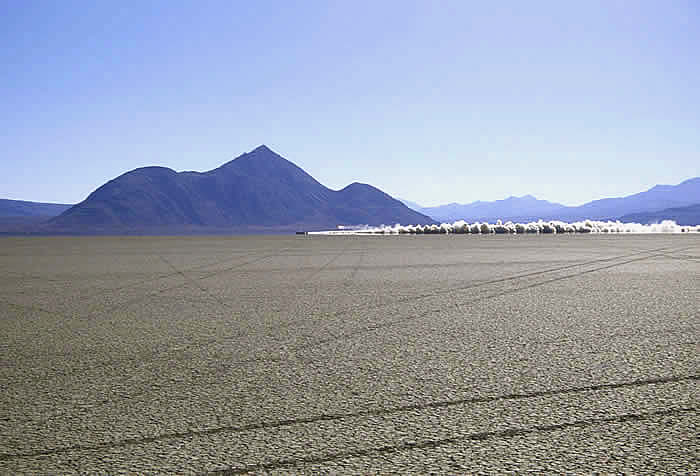
Spirit of America - test run - Bonneville
The
World's Fastest Automobile Race
Sports
Car International Magazine
By Sam Low
The World Land Speed Record
The date is October 15, 1964. Craig Breedlove pilots Spirit of America
I through the flying mile at Bonneville's land speed record course. As he
exists the speed traps at over 550 miles an hour, flame extends twelve
feet beyond the car's jet exhaust. A white plume of salt rises from her
wheels. In the cockpit, Breedlove presses a button to ignite a powder
charge in a parachute canister at the car's tail. He feels a slight tug
as his braking chute opens. Then nothing. The chute has failed. Streaking
past a marker indicating three miles of track remaining, the speedometer
indicates 460 miles an hour. Craig deploys his emergency chute. Nothing.
At the end of the track, he tries his disc brakes. His foot goes to the
floor. Shaped to slip easily through the air, Spirit of America continues
off course with great velocity, glances off a telephone pole, climbs an
earthen dike that constrains a pool of water, and flies. The vehicle skips
across the pool in a series of ever tightening arcs and comes to rest,
nose down, with her cockpit in six feet of water. Breedlove emerges unscathed
and with a new world record of 526.277 miles an hour. A few months earlier,
Glenn Leasher had perished in the wreckage of his jet powered car. In
1963, Athol Graham died when his City of Salt Lake crashed on the same
course.
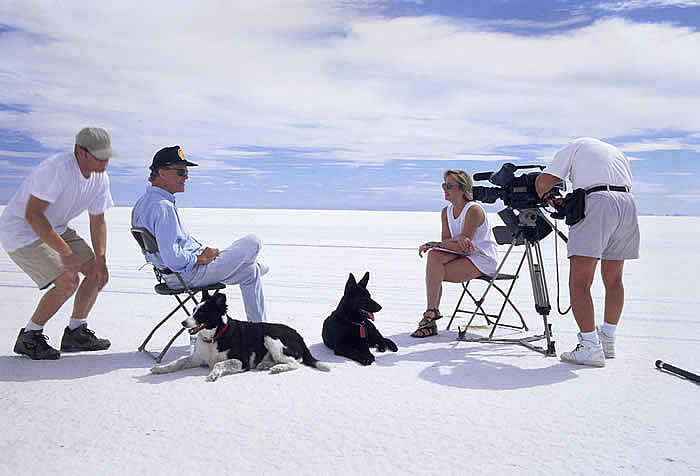
Craig - his dogs - and the media
Time warp forward thirty-one years to October 21st, 1996. Breedlove, now
59 years old, still looks the youthful "Captain America" who captured
the land speed record five times and set a record of 600.61 MPH in 1965.
He is a PR man's dream - handsome, articulate impassioned. Craig first
traveled to the Salt Flats on the window ledge of a '46 Ford hot rod driven
by a neighborhood teenager. He was then fifteen. From that moment he has
focused his life on the land speed record - often at the expense of family
and personal fortune. Now, after a thirty year enforced leave of absence
when public interest shifted away from speed, Craig has created a new
Spirit of America to break the record which, in the interim, has been
set by Englishman Richard Noble at 633 miles an hour.
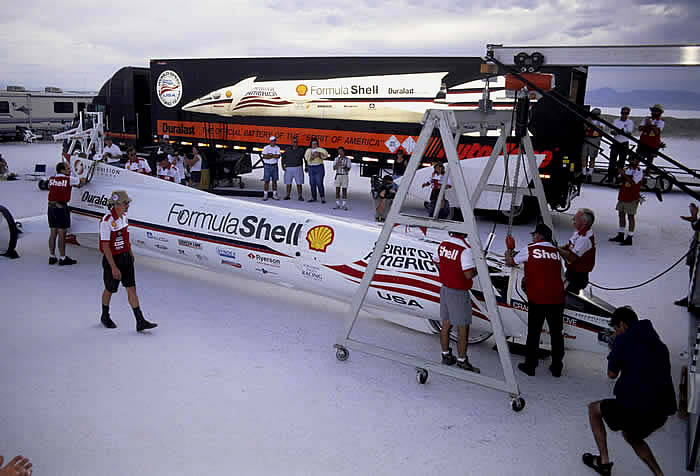
Spirit is unloaded from transporter
Spirit of America
Every engineer knows that it's a mistake to anthropomorphise a machine,
yet with Spirit of America the temptation is irresistible. Pure white,
44 feet from tapered nose to her stainless steel afterburner, she resembles
a rocket ship that addresses the earth rather than the havens. Air intakes
that feed her 43,000 horsepower General Electric J79 jet engine protrude
from each flank and rise gracefully, like a Vulcan's ear, to a point.
A dorsal fin arcs serenely aft, then spirals home like the knurl of an
upturned Stradivarius - a steering vane. Two rear wheels of very large
diameter are encased in pods which are cantilevered for stability and
raked back for aerodynamic efficiency. The pods terminate in a scimitar's
curve. This new Spirit of America was fashioned by Craig Breedlove with
a vision that proportioned equal weight to speed and beauty.
Riding in Spirit's sloping nose, Breedlove intends not to just beat Noble,
but to be the first to exceed 700 miles an hour. Then, in what many regard
as a fool-hardy extreme, he will accelerate fast enough to penetrate the
sound barrier. It is a challenge that Richard Noble has accepted. He,
too, has built a car capable of supersonic speed which he calls "Thrust
SSC (supersonic car)" after the original machine, Thrust II, which propelled
him to the world record. Should either of these men realize their intent,
they will be exploring what scientists call a technological and scientific
frontier.
The Sound Barrier
Dr. Seymour Bogdonoff is the Robert Porter Patterson professor of Aerospace
Engineering at Princeton University. He is 75 years old, slender, with
active gray eyes and an open face. Bogdonoff was a scientist with NACA
(the organization that later became NASA) during the period when aircraft
were approaching the speed of sound for the first time.
"There is an eerie parallel between what is taking place today with these
land speed cars and what happened in the air during the forties," Bogdonoff
told me in his cramped office at Princeton's Gas Dynamics Laboratory.
"There was no sound barrier. It was an ignorance barrier. We tried to
push planes designed for 400 miles an hour through the air at 700 miles
an hour and they crashed."
"Imagine you are walking and that at the same time you are singing a song,"
Bogdonoff explains. "The notes of the song spread out in a circle around
you at the speed of sound. Sound waves are infinitesimal pressure disturbances.
They fan out ahead of you. Now imagine that you are riding in a car, and
you speed up. Those waves ahead of you are still going faster than you
are but now they are closer together. Behind you, the waves are further
apart because you are moving away from them. If you accelerate to go as
fast as the sound waves, all those waves end up right there with you.
Each of them is infinitesimal, but if you stack a whole batch of them
up, they become finite. They become a shock wave."
When a modern airplane goes fully supersonic, the shock wave trails away
from the craft much like the wake of a boat. Behind the shock wave, air
pressure increases dramatically. When the wave whacks the ground, the
pressure change is felt as a sonic boom which may be powerful enough to
shatter windows. Modern supersonic aircraft fly high to reduce the impact
of their shockwaves, but when a land speed car achieves supersonic speeds
only inches from the earth's surface, the resulting pressure increase
may lift the vehicle off the ground. The ensuing flight would be dramatic,
of rather short duration, and almost certainly fatal. "Breedlove and Noble
are trying to accomplish a very dangerous thing," Professor Bogdonoff
told me. "If they don't know what they're doing, it's going to be like
those poor pilots we killed in the late forties."
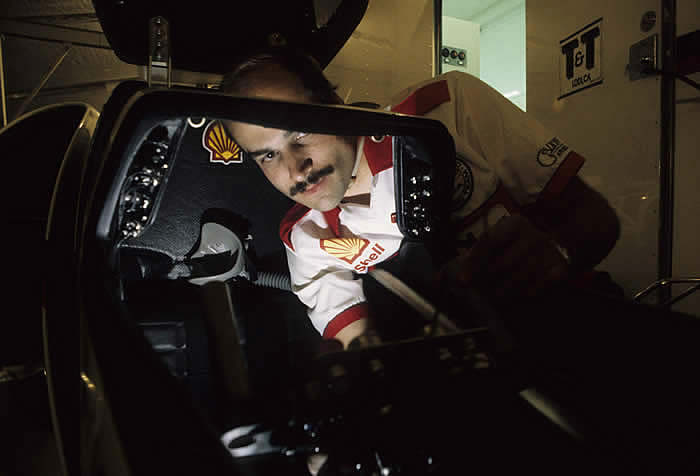
Technician checking Spirit's electronics
Black Rock
The small town of Gerlach, Nevada, population 350, huddles against the
flank of the Granite Mountains. It is a monotonous landscape that presents
muted earth tones as far as the eye can see. North of the town the land
continues in its unbroken flatness but now shifts color from yellow and
tan to a gray pallor which marks the beginning of the Black Rock Playa
- alkaline silt - in some places reported to be 10,000 feet deep, all
that remains of ancient Lahontan Lake which formed at the end of the last
ice age. The dried and caked lake bottom, eighteen miles long from northeast
to southwest, is the world's perfect land speed record track.
On October 21st, 1996, I travel to Black Rock to observe Craig Breedlove
and his team as they attempt to set a new land speed record. Crew chief
Dezso Molnar takes me on a tour of the car. I am quickly made to appreciate
that its elegant design stems from a simple motto, "keep it simple, stupid."
Take the brakes, for example. The car will be slowed from top speed by
a parachute that will pop out of its nest under the jet engine, pretty
standard fare for high speed vehicles. But to come to a stop, Craig has
employed a novel device.
"Down here we have what we call our Fred Flintstone Brake," says Dezso,
pointing to a metal ski protruding from Spirit's nose. It is designed
to extend and drag on the ground once the parachute has bled the car's
speed to about 75 miles an hour.
v "The brake is hydraulically actuated. It will dig into the dirt or whatever.
This car has very low drag and a lot of mass, nine thousand pounds, so
it will just cruise and cruise and cruise if we didn't have something
to stop it."
Although it may seem a simple device, the ski brake is an example of the
way Craig thinks through every detail of his car and often comes up with
novel solutions. To stop a car with normal brakes, a pad of heat resistant
material acts on discs attached to the wheels which, in turn, act through
their contact patches on the ground. Adding up the area of the contact
patches of all of Craig's wheels gives about 200 square inches. But the
ski brake will spread more than 240 square inches of material to the ground,
and it will do so directly, without any intermediary actuating devices
like calipers or pads or discs. The brake is both simpler and more effective.
"Getting a car like this going is not the problem," Craig says, "it's
getting it stopped. It takes about a mile just to shut off the engine
when I'm traveling a mile every six seconds. The car is a voracious consumer
of distance. It eats land."
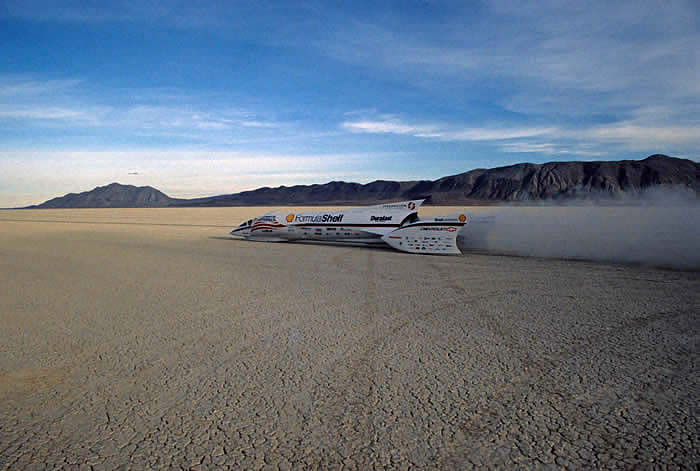
Spirit at Bonneville
The Fury of the Wind
In spite of the fact that Richard Noble and Craig Breedlove have been
locked in an advanced form of technical combat for years, their obsession
with speed has also created a unique bond. It is like that shared by the
cognoscenti of odd subjects, a love of frogs, say, or plasma physics,
to which you must add the bond of shared danger. In 1983, when Richard
Noble was attempting to set a new land speed record, Craig traveled to
Black Rock to watch. He ended up by helping.
"I remember that when Richard was trying to break the record he was having
trouble getting beyond about 620 miles an hour," Craig recalls, "so I
talked with him about the angle of attack that would be necessary to offload
some downforce to get the record. We went from a zero angle of attack
to .028 positive, a fraction of a degree positive, and then I left. He
went through the record on the next run. He was "land bound." Until some
of the rolling drag was reduced, the car was not capable of exceeding
the record."
The force of the air acting on a vehicle increases with the square of
the vehicle's speed, so a slight misalignment of a record car with the
wind may cause it to either lift - to fly - or to press down on the ground
with such force that rolling drag inhibits its speed. By increasing Thrust's
angle of attack very slightly, Noble increased lift to reduce rolling
drag and take the record. But that infinitesimal adjustment, only .028
of a degree, was a calculated risk. Reflecting back on the moment, Richard
Noble says, "Thrust II nearly flew. We got to within seven miles an hour
of takeoff and at those speeds with dynamic pressures of ¾ of a ton for
every square foot of body work, it would have been a 40 G takeoff."
Noble's new car has twin engines slung on either side of it's fuselage
so it presents rather large surfaces for the air to work against. To accommodate
the difficulty of aerodynamically trimming Thrust SSC, Noble has designed
what he calls "an active ride" system. Sensors mounted on the wheels detect
the amount of aerodynamic force pressing down on them. They feed that
data through a ganglia of wires into a computer which assesses the car's
balance in microseconds and sends orders to hydraulic mechanisms to raise
or lower the tail of the car - to adjust the angle of attack - or, as
Noble puts it, the incidence of the car to the wind.
"We can vary incidence at any mach number or increment of mach number,"
Noble says. "At mach .9 we might find a minus quarter of a degree of incidence
is appropriate and at mach .93 we might want a different ride incidence.
We are optimizing the car for changing running conditions."
Breedlove, on the other hand, has designed a car that does not address
the wind with large surfaces. Spirit is pencil thin, it's underbody rounded.
He does not employ "active ride," but he does have numerous aerodynamic
surfaces that can be adjusted to control its balance at the beginning
of each run.
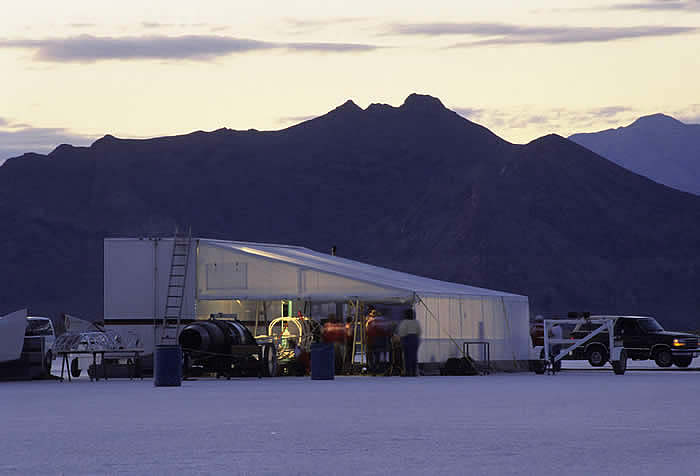
Spirit of America base station
A Perfect Run
Black Rock, Nevada. On Wednesday, October 23rd, a rain shower slicks the
playa, then dries quickly under the baking sun. At 3:15 PM Craig shoehorns
into Spirit's cockpit and takes her to 441 miles an hour on the first
high speed test. With the exception of a slight case of parachute misbehavior,
the car performs flawlessly.
During the night, a low pressure system moves down from Canada. A finger
of disturbed weather extends across the Black Rock desert, bringing rain.
In the morning, ragged clouds scud over Gerlach and water stands in ugly
gray puddles. The results of the previous day's run buoy the team's spirits,
but winds sweeping off the Granite Mountains gust to 60 miles an hour.
The desert is closed.
"Waiting, it's one of the most difficult things we have to do," a crew
member tells me. "But the record should be ours if the weather will just
cooperate."
Shock Waves
But Breedlove and Noble are after more than merely setting a new speed
record. Both men want to be the first to break the sound barrier on land
- the ultimate test of technical ingenuity and human courage. "It's something
that I've had years to think about," Breedlove once told me, "every single
aspect of it. I go to bed almost every night thinking about it and I wake
up the next morning with the same thought in mind."
One of the things that most occupies the minds of both Breedlove and Noble
are those shock waves that will stream off their vehicles when they reach
the speed of sound. It's the same phenomenon that caused pilots and scientists
to think of an invisible "barrier" that destroyed aircraft trying to go
supersonic in the '40's.
Many of the incidents experienced by early experimental airplanes actually
occurred before they went supersonic, at speeds between Mach point eight
and Mach one, a dangerous regime that aerodynamacists call "the transonic
zone," where local shock waves form on an aircraft's control surfaces.
Such local shock effects can be expected to cause problems for both Spirit
of America and Thrust SSC. Spirit of America, for example, uses control
surfaces similar to an aircraft's to achieve aerodynamic balance - trim
tabs mounted on the trailing edge of wings which encase its two rear axles.
If Spirit's nose is pitching up, Breedlove will deflect the trim tabs
down. If the nose pitches down, the tabs will be adjusted up. At high
speeds, the craft's aerodynamic balance depends both on the precise positioning
of these trim tabs and a smooth flow of air over them. But in the transonic
zone, the air is almost never smooth.
Consider Spirit of America as it approaches the speed of sound, about
760 miles an hour on an average Fall day. Imagine that she is doing 700.
Air particles speed up as they pass over the curved surface of her rear
axle wings. Imagine now that they exceed the speed of sound and a local
shock wave appears - it's a little one, so in itself it's not very dangerous
- but what happens next is. At the shock wave, air pressure soars, which
disturbs the orderly flow of air over the wing and causes eddies to form,
nasty swirling vortices of air which spill over Breedlove's trim tabs.
"If the air is not attached to the wing in a nice orderly flow, the trim
tabs may be in a region where there is very little air flow over them
and so they will not work as Breedlove designed them to," says Seymour
Bogdonoff. Depending on a variety of factors this will, in turn, cause
the nose to pitch up or down, and Spirit of America will attempt to travel
to China - either by piercing the earth or by achieving orbit.
Pressure Reversals
Both Breedlove and Noble are convinced that they experienced local shock
waves during previous record runs. The phenomenon occurred at only about
600 miles an hour, well below the speed of sound. In both cases, the shock
waves seem to have built up beneath the car where the air is sped up as
it is compressed between the car's bottom and the ground. At subsonic
speeds, this produces an area of low pressure which sucks the car to the
pavement, an effect called downforce which is used by modern racing machines
to increase traction. But this effect may actually reverse as the car
approaches the speed of sound.
"At lower speeds, you get a venturi effect beneath the car and a venturi
gives you suction and suction sucks the car down, " says John Ackroyd,
the designer of Richard Noble's earlier record setting car. "On our record
car, we had plenty of downforce, enough to be driving the wheels into
the desert and costing us a lot of drag. But that seriously reversed when
the air beneath the car went supersonic. It's a fact that a supersonic
venturi, far from creating suction, creates pressure and pressure beneath
the car creates lift. The minute we hit a very high speed, you could see
the dust spurt out sideways from underneath because the pressure was rising
there and pumping the dust out."
The effect of this pressure reversal could of course be catastrophic.
Imagine either car proceeding at near supersonic speeds, perfectly balanced
by the flow of air over their surfaces, with just enough air pressure
forcing them down so they will not fly - but not so much pressure that
they are slowed by rolling resistance. Now imagine that a pressure reversal
occurs beneath the car, perhaps substantially pitching the car's nose
up into the fierce stream of wind…
Breedlove, as usual, has adopted a common sense approach to dealing with
this problem. Spirit's underbody sections are both rounded and vee-shaped
which, he hopes, will give the increased pressure less surface to work
on.
Noble's critics argue that Thrust SSC's large flat bottom will provide
an ideal surface for even the slightest pressure change to react against
and hence increase danger as the car enters the transonic zone. But noble
is sanguine. He has tested his car using advanced computational fluid
dynamics, a computer program that solves for the flow of air over its
surface and plots where shock waves will form. He has also affixed a 1/25th
scale model on a rocket sled and run it at supersonic speeds over the
ground, measuring the effect of the shock waves on the model. The two
different techniques produced the same result, giving Noble confidence
that he knows exactly what will happen when Thrust II enters the transonic
zone.
When I asked Noble what this research revealed, he told me, quite reasonably,
that the results had to be kept secret until after the "race" had been
won. But by using a calculated scientific approach, both Richard and his
aerodynamacist, Ron Ayers, are convinced that they have indeed achieved
a revolutionary understanding of supersonic air flow. "The idea of a vee-shaped
fuselage (like Spirit's) means nothing," says Ayers, "because nobody who
shaped it that way actually knows what happens with the shockwave. But
we do. Through the rocket test I know exactly what happens to the airflow
under the car and to the shockwaves. It's like we've tackled the problem
head-on, where others have tended to shy away from it and avoided actually
investigating it."
If it is fair to liken science to a river of knowledge, then Richard Noble
and Craig Breedlove stand on opposing banks of the river. It is not just
that they are two very different personalities, but that they have arrived
at the river by traveling through vastly different terrain. Breedlove
represents an American path toward speed which curves through the rough
and tumble yet immensely pragmatic world of drag racing. In England, where
such sport is almost non-existent, Noble has taken a route which lofts
through the theoretically charged realms of aerospace research.
"Richard is trying to scientifically model the physics of supersonic travel,"
Craig once explained to me, "but using a tiny scale model and questionable
theory is setting yourself up to get bad data - and bad data is worse
than no data at all."
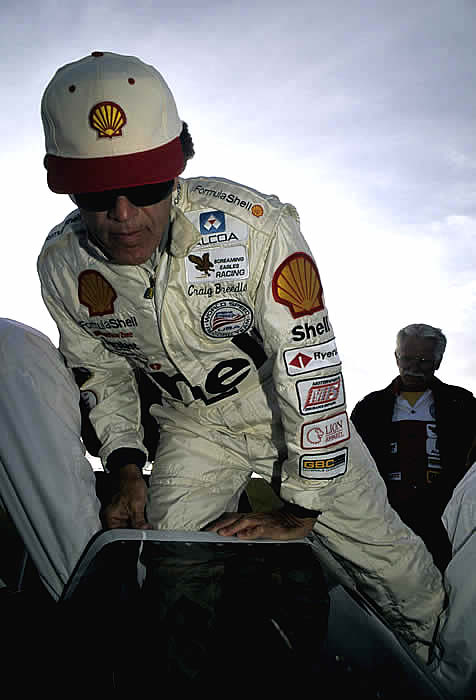
Craig Breedlove shoehorns into Spirit
The Record Run
Black Rock, Nevada, Sunday, October 27th. After four days of rain, the
sun once again bakes the surface of the desert. At 1:27 PM, Craig Breedlove
takes Spirit of America on a perfect run to 562 miles an hour. The record
now seems within easy reach - only eighty miles an hour away. Weather
forecasters predict that Monday will bring calm winds and mild temperatures;
but satellites also detect winter storms poised to sweep across Nevada.
There will be one day, and one day only, to set the record.
At 7:30 AM on Monday morning, an ambulance proceeds across the lake bed
without raising dust. It is below zero. Ice crystals sheen the desert
surface. Team engineer Walt Sheehan is in a pickup truck with the heater
blowing across sheets of graph paper on which he has plotted a curve that
predicts Spirit's speed at various distances. He is concerned with such
matters as engine thrust and aerodynamic drag, but what most occupies
his mind is the car's aerodynamic balance. The team has retained the wing
settings that worked at 562 miles an hour, but how will they perform in
the transonic zone?
Spirit's first record run is defeated when the afterburner, a device that
increases power by injecting fuel into the car's fiery exhaust, does not
light. At the east end of the track, The car is turned around. Sheehan
increases fuel pressure to coax the burner to function.
At 11:45 AM, as Craig straps into Spirit's cockpit, the radio crackles,
a report from the west end of the track: "You have a wind of one five
down the course."
Someone says, "does that mean fifteen knots or only one and a half?"
The radio, which has been cutting out all day, remains silent. The wind
is still at this end of the track so the crew assumes a knot and a half
of head wind. Perfect conditions.
At 11:54 AM, the car explodes down the desert leaving a stream of dust
and flame. Entering the flying mile, Spirit strays slightly to the left
of the course. Craig corrects. Suddenly, the car swerves right, lifts
its right wheel 45 degrees and veers sharply off the track. In the cockpit,
Breedlove fights to regain control, battling forces in excess of six Gs
- six times the force of gravity. With hands as heavy as lead, he reaches
for the fuel cutoff switch.
From the air, a spotter plane radios that the car is out of control, that
it's sliding on its side, that Craig appears to be having difficulty shutting
down the engine. The pilot watches helplessly as Spirit completes the
world's fastest U-turn and heads back the way she had come. He sees Craig
deploy Spirit's parachute. This time, it works.
Later, on-board computers revealed that Spirit of America was going 675
miles an hour when Craig lost control. Had she continued on course, Craig
would have broken Noble's record.
It's still too early to tell what caused the accident. Perhaps local shock
waves, forming on the rear wings, disturbed the car's delicate aerodynamic
balance. Some observers saw a puff of dust under the car's rear wings.
A pressure reversal may have occurred beneath the car. Craig is certain
the after burner produced excessive much thrust which caused him to modulate
the throttle. This may have destabilized his rocketing machine. Haste
is one certain culprit. With only one day to set the record, the team
abandoned its cautious plan of incremental speed increases. And there's
one other thing: the wind speed just before Craig launched was fifteen
knots - one-five, not one point five. When Craig discovered that particular
error he said, "I would never have launched if I'd known that. Wind -
that's the most basic taboo of all."
The team has now returned to their base in California to ponder and to
rebuild. In the Fall of 1997, they will return, but it's almost certain
that this time Spirit will share the desert with a hostile camp. On November
12th, at Al Jafr, Jordan, Thrust SSC achieved a top speed of 331 miles
an hour followed by a problem with her rear wheel steering system. Flooding
of the desert caused the English team to abort further runs. But according
to Noble, Thrust will be ready to directly challenge Spirit of America
at Black Rock when the land speed course opens on September 2nd. Always
the master of sound bites, he calls it "the world's fastest automobile
race."
The photographs that accompany this article were taken at an earlier test run at Bonneville |








